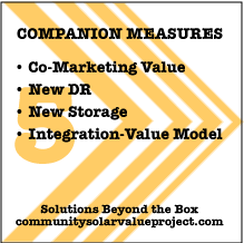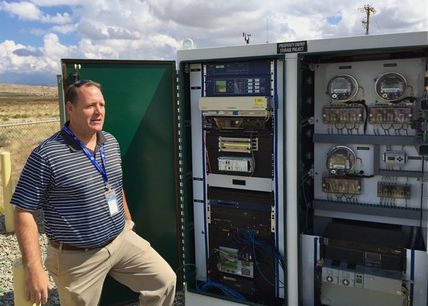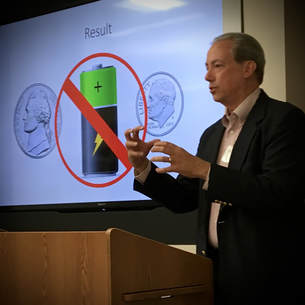5: Solar-Plus Companion Measures
Interest in solar-plus storage has boomed since CSVP first proposed addressing storage and demand response (DR) as companion measures for community solar. In fact, the Solar Value Project as evolved in 2020 to the present with a focus on solar-plus, including our Solar-Plus for Electric Co-ops program (also suitable for public power systems), and work on solar plus strategic energy efficiency and electrification, which can help to achieve energy equity goals. Note that our current work will also give you a library of sample solar-plus-storage RFPs and procurement advice that is up to date.
Going back the our CSVP work, we recognized that companion measures do not have to be exclusively tied to the community solar offer, but planners can benefit from an integrated program-design perspective. The CSVP team pioneered solar-plus-DR strategies, and our guide to DR companion measures (below), including storage water heaters, is still current. Also, the attachments and webinar material presented here provides an excellent foundation for utilities that are just beginning to think about how solar-plus-storage and load flexibility could mesh with other local solar development plans. We suggest starting here and then checking out the Solar-Plus tab. Our first modeling study of solar plus storage and DR, prepared with Utility Forum member Public Service Company of New Mexico (PNM), introduces the technical value of a solar-plus “triple play.” Planners can gain an in-depth, practical understanding from CSVP's guide to DR measures and guide to storage measures (see below), including those on either side of the meter to complement a community solar offer. An annotated list of resources is a useful companion guide. These are the first documents of their kind, taking the program planner's perspective, to help deliver solar-plus innovations as scalable, saleable and replicable utility program options. Also included here: a webinar and presentations on strategies that offer a practical way to start. |
Here, CSVP Utility Forum participants from Public Service Company of New Mexico (PNM) share a technical perspective, which may be a starting point for a cross-departmental discussion about the value of community solar “plus.” This modeling study looks at the grid benefits of combining well-sited solar with storage and demand-response (DR) measures. It uses field data to model and optimize the strategy, as it would mitigate low-voltage issues on a local utility feeder. The report concludes that a combination of distribution-scale solar, plus DR control of customer thermal storage, would eliminate all instances of low voltage in the optimized scenario tested. This study demonstrates the methodology and underscores the importance of including technical as well as market and policy considerations in designing a high-value community solar plan. In addition to the report, we include a presentation from its co-author, PNM's Jon Hawkins.
| 2017_09_28_pnm_grid_benefits.pdf | |
| File Size: | 1959 kb |
| File Type: | |
| 14_2017.06.08_pnm_hawkins.pdf | |
| File Size: | 904 kb |
| File Type: | |
Demand-Response Companion Measures for High-Value Community Solar Programs: A Guide for Utility Program Designers is geared to assist utility program planners in including demand response (DR) measures for co-marketing with distributed solar, and particularly with community solar programs. This guide is also useful to DR program managers, utility resource planners, and others who wish to understand how different applications of traditional DR are evolving to address new high-value opportunities in renewable-energy integration. The tone is introductory, but it is the first guide of its kind, recognizing that DR can sometimes play the same role as battery storage, while providing a new tool for customer engagement and retention.
| 2016_04_12_integrating_dr_guide_updated.pdf | |
| File Size: | 873 kb |
| File Type: | |
Solar Plus Storage Companion Measures for High-Value Community Solar: A Guide for Utility Program Planners is geared to help program planners assess storage technologies and configurations that work on either side of the customer meter, to meet changing utility needs. Suggested solar-plus strategies demonstrate integration value and test program designs, which could be scaled up for greater impacts. A range of utility-side options are summarized, but the emphasis is on customer-side battery storage and thermal storage options that are most readily available and cost-effective today. The guide defines integration value streams in basic terms, and it includes a scoring matrix to help planners prioritize which technologies and configurations would best meet their needs.
| 2017_09_30_final_6_solar__storage_guide.pdf | |
| File Size: | 2308 kb |
| File Type: | |
Resource Links for Solar Plus Storage is an annotated bibliography, with links to background information on current energy storage markets and strategies, and with particular focus on market-ready options for pairing with community-scale solar today. Both utility-side and customer-side storage options are addressed, including customer-side thermal storage options which are often overlooked. For example, controlled water heating and ice storage systems are covered, as well as and strategic, small-scale batteries and electric vehicles (EVs). This document is a good companion to the CSVP storage and DR guides offered above.
| 2017_7_26_storage_links.pdf | |
| File Size: | 297 kb |
| File Type: | |
05.11.2017: Best Steps You Can Take to "Solar Plus"
In spring 2017, CSVP produced webinar that previewed CSVP storage strategies and traced how Hawaiian Electric has taken dramatic first steps to using storage to help achieve an aggressive goal to rely entirely on renewable resources in coming years. Join John Powers, CSVP Contract Officer and CEO of Extensible Energy, with Rich Barone of Hawaiian Electric for a remarkable discussion.
In spring 2017, CSVP produced webinar that previewed CSVP storage strategies and traced how Hawaiian Electric has taken dramatic first steps to using storage to help achieve an aggressive goal to rely entirely on renewable resources in coming years. Join John Powers, CSVP Contract Officer and CEO of Extensible Energy, with Rich Barone of Hawaiian Electric for a remarkable discussion.
| 2017_05_11_webinar_jp_2_1_.pdf | |
| File Size: | 936 kb |
| File Type: | |
| hawaiian_electric_der_management_initiatives_1.pdf | |
| File Size: | 828 kb |
| File Type: | |




